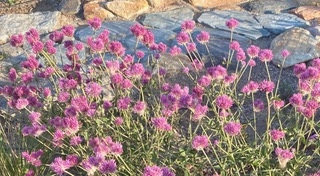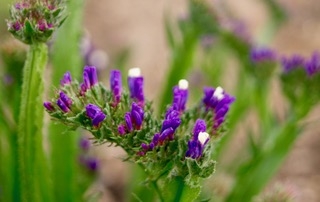I recently unearthed a bouquet of blue statice that I had hung to dry in the pantry, and it now brightens my bathroom, along with some ‘Moonshine' yarrow and lavender harvested early last summer.
Though I do have some star performers in my desert garden, I'm afraid nothing will ever quite compare to the armloads of easily-grown flowers I could collect nearly any day in Santa Cruz. When I saw those statice, it occurred to me that I could extend my season of color by planting even more flowers for drying. I did a little research and came across this amazing site that inspired me to expand my palette of dried flowers.
Globe amaranth (Gomphrena globosa) is a super-tough little annual from South America that blooms in late summer. It is so tolerant of high temperatures that there used to be a notion that it was planted at the gates of Hades. Now that's hot! I grew it 20 years ago when I lived in west Bishop, and I remember it as a welcome—if not too exciting—addition to the flower bed. But seedsmen and plant breeders have been paying attention to this little guy, and you can now find it in oranges and reds, in addition to the white, pink and purple I remember. The colors that make globe amaranth so striking actually come from stiff, papery, leaf-like structures called bracts—the same part that makes poinsettias and bougainvilleas so attractive)—the true flowers are so tiny that they are nearly hidden within the flower head.


As I alluded to above, statice (Limonium sinuatum) has become a staple in my garden over the years. With statice, it's the flower sepals (collectively known as the calyx) that provides the color—the white flower petals fall away. Statice is super-easy to grow from seed, and they now come in so many more colors than the blue I have always grown.
And there are so many other possibilities to explore!
Many of us have grown the common annual bachelor's button (Centaurea cyanus). You may also know it as cornflower, so named because it was often found as a weed in fields of corn and other grains. Another familiar plant is the aptly-named strawflowers (Xerochrysum bracteatum). I'll bet you can guess what plant part provides this Australian import with its color! The big news with so many of these dried flowers is the new hues plant breeders have brought us.
Less familiar to me are the celosias (Celosia angentea cristata), which come not only in different colors, but in three different flower types: plumed, cockscomb and wheat! Sunballs (Crasspedia globosa), sea holly (Eryngium planum)and globe thistle (Echinops ritro) are three more to check out.
And you don't have to stop at flowers. Many grasses (bunny tails are nice) and members of the onion family are great in dried bouquets. In my own garden I discovered that the dried stalks of garlic chives are beautiful in the autumn garden, especially mixed with ornamental grasses and late bloomers like goldenrod. The problem, of course, is that by the time they are dry, they have spread their seeds far and wide!
As easy as most of these plants are to grow, drying the flowers is even simpler. Cut them when they first open, bundle them with string and hang upside down to dry. Florists sometimes use drying agents like silica gel, but my favorite method comes from a grower who tosses the flowers in the trunk of his car, parks it in the sun, and says they are perfect after 24 hours!
For more information on flowers to dry:
Select flower names in the articles to see photographs and more detailed descriptions.
- 30 of the best flowers for drying
- Grow everlastings for dried flowers
- Gomphrena—an antidote for the late summer blahs
*Brazilian verbena has become invasive in some warm-winter areas of the country, but our temperature extremes seem to prevent that here.
